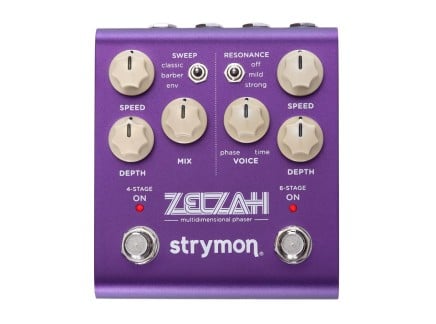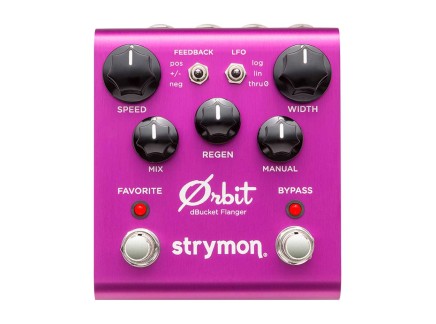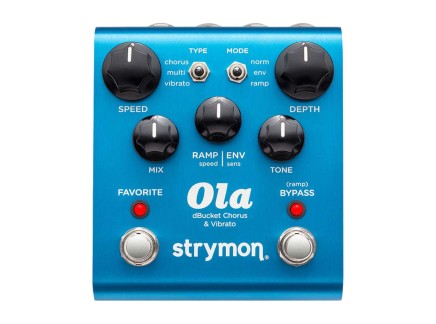Let's get one thing clear: phasers are rad! Similar to their delay-based cousin, the flanger, phasers apply a swirly and smeared effect to your instruments and audio via the lovely help of all pass filters. We can thank the wonderful pioneers of the 70s for this classic effect, and this year, Strymon has upgraded that nostalgic modulation source with a more modernized sound palette with their wonderful Zelzah.
I may have been the one to mention it as one of the best pedals of the year, but most of us here found it to be a massive hit. Like many of Strymon's pedals, Zelzah provides much more than meets the eye with two highly shapeable phasers that compliment anything you put through them. Historically used on electric guitars and electric pianos, phasers expand upon your instruments' liveliness by sweeping the phase of a multitude of cascading all pass filters to produce a vocal sounding effect—this can be heard throughout rock, funk, electronic, and so many other genres. Providing quintessential four and six-stage settings, a collection of musical and flavorful parameters, and several routing options, Strymon's Zelzah has proven to be a hit that we here at Perfect Circuit all adore.
More Than a Phaser…
You know when people say effects and processors have "a sound"? Zelzah has one, and that sound is as close to modulation majesty as you can get. Strymon carefully tuned every parameter of Zelzah to make it a tasteful and usable studio tool while still being highly useful in experimental settings like sound design. Broken into two distinct and separate phasers, each half of Zelzah can act independently or in tandem with routing options for series and parallel processing, making for a versatile two-in-one style pedal. Looking at their similarities, each phaser features two controls that determine the amount and speed of modulation applied to the stages, defined by Depth and Rate, respectively.
Focusing on each half individually, some differences become clear: the left half of the pedal is a four-stage phaser, while the right half is a six-stage phaser with slightly different tone-shaping options. One of the defining features of the four-stage effect is its ability to blend between the dry and wet signal via the Mix knob. Much like a vibrato/chorus pedal, the phasing happens with a blended signal, yet when approaching the maximum mix setting, Zelzah produces amazing tremolo and vibrato-like effects depending on the Sweep mode you select. Speaking of, the Sweep choices provide you with several modulation features to determine how the four-stage section reacts, starting with the classic mode for traditional phase shifting. The barber mode produces the barber pole effect of continuous rise and fall of frequencies for creating expansive textures, while the env mode sweeps the frequencies based off an envelope follower of your input signal, acting more like an auto-wah-type effect. These modes in combination with the depth, rate and mix controls give a wide range of sonic exploration for neo-classic takes on phasing.
Shifting our focus to the six-stage side, we will see the mix control position is taken by a Voice control, blending from phaser to flanger to chorus tones. Expecting nothing less than genius from Strymon, Zelzah's six-stage phaser introduces no delays in the signal path, but rather shifts the time response of the all pass filters to match the tonal qualities found within flangers and choruses, creating hybrid types of effects you can't quite find anywhere else. Zelzah's Voice parameter is probably its most fantastic feature given how continuous the blend between effects is, making it even more sought-after as a performance tool. For control over how potent and resonant these effects can come off, the resonance switch provides a mild and strong boost to flip to for whiney phasers and flangers and shaky choruses.
Of course, these phasers would be cool enough as two mono effects in series, but Zelzah doesn't stop there. Because Zelzah is true stereo, each section of Zelzah runs two phasers of the same type, meaning dual four-stage and dual six-stage phasing. Each half of Zelzah can generate its own stereo image by introducing a phase offset for the LFO's effect on each stereo channel, ranging from dual mono all the way to 180-degree out-of-phase modulation—this works on mono or stereo inputs! Zelzah also provides three different routing options for processing your signals, including a series mode running from the six-stage into the four-stage, a parallel mode in which each phaser independently processes the input and sums at the end, and a split mode that processes a mono or stereo input where the left output is from the four-stage and the right output is from the six stage. In combination with offsetting the phase of each section's LFOs, you have a wide variety of options for creating unique and interesting stereo phasers.
Zelzah's versatility in sonic and spatial sculpting is truly remarkable and can be heard beautifully in Jacob's fantastic demonstration with his eight string in the video above, achieving funky and emotive chord progressions as well as swishing and talkative bass thumps. With further performability via expression pedal and fully MIDI spec'd controls, the Strymon Zelzah proves to be a fascinating modulation effect that would complement any setup, be it performance or studio.










